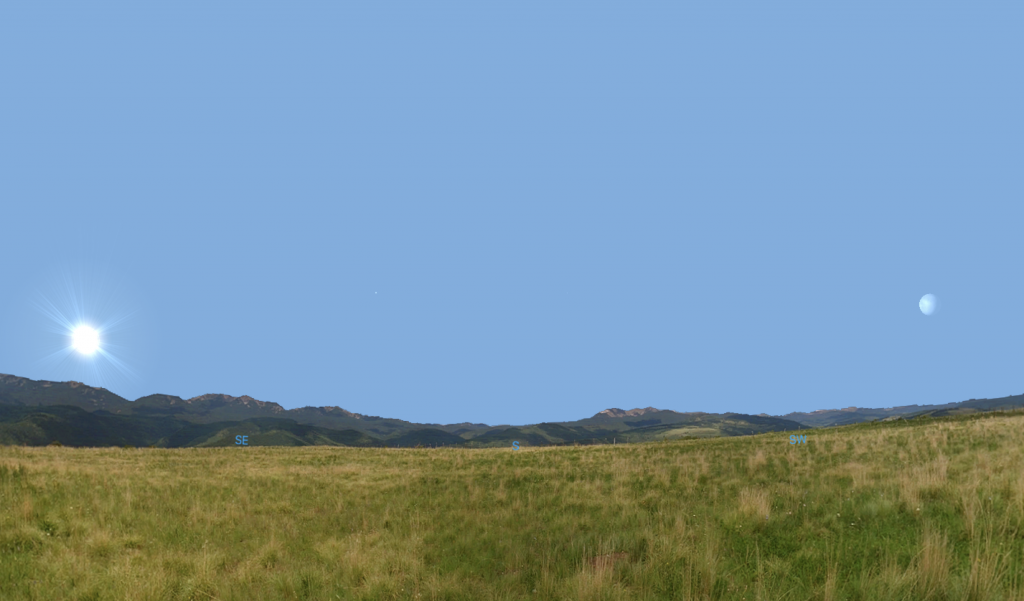Chapter 1 Part 3: Investigating the Motion of the Sun

Science Notebook Assignment
This is the third investigation under the heading of naked eye investigations that is addressing its own question, so you need to create a third new note to keep and organize all of the work you do for this investigation. As with the previous two investigations, please record all important information during your work on this investigation, and be sure to organize it well.
Investigation question:
How does the Sun appear to move on the sky throughout a day, and why does it move that way?
Perhaps the only astronomical object more familiar to us than the Moon is the Sun. From your everyday experiences, you may already feel read to answer the first part of the question asking how the Sun appears to move during a day. So to begin, you should sketch a prediction that describes how you believe the Sun appears to move during a typical day. If you can, you should label your sketch and indicate as well as you can on the sketch how the motion proceeds.
Science Notebook Assignment
Record your prediction in your notebook that includes your sketch and your short, written description for how you believe the Sun appears to move over the course of a day. Include all of the details you think may be relevant.

Data collection with Starry Night
You should start Starry Night and set the date for today’s date and the location to your current location. Experiment with the software in order to make observations that allow you to trace the Sun’s path on the sky for today. Decide on a method for recording the data from Starry Night as individual observations of the Sun that you can record in your science notebook. Look for a pattern in your data that answers the investigation question.
In your group, share your evidence with the other group members, and then discuss an initial claim that answers the first part of the investigation question: How does the Sun appear to move on the sky throughout the day. Decide in your group what is the proper amount of evidence you need to support this claim well.
In your groups, begin to discuss the second part of the investigation question: Why does it move that way?
- Do you have an initial idea that can explain the pattern in the Sun’s apparent motion?
- Is there a model you can create that can reproduce this motion?
Science Notebook Assignment
Record your initial claim and evidence in your notebook. Record any ideas that you group generated for potential scientific explanations for why the Sun behaves as described in your claim.
Optional additional evidence gathering
Building a model to provide scientific reasoning to support your claim about the apparent motion of the Sun
This investigation lends itself well to a kinesthetic model like the one you can construct to explain the appearance of the Moon. Your instructor will stand in the center of the room to model the Sun (or alternatively, you can use a yellow helium balloon or a large yellow ball to represent the Sun). All students will gather in a big circle around the model of the Sun, and in this model, like in the Moon model, you can pretend that your head is the Earth. You can imagine that there is a little model of you standing on the tip of your nose, and so what that little you sees of the modeled sky is what you are seeing as you act out the model.
- In this model, in what ways should you move to represent the Earth’s motion?
- When you are facing directly at the Sun (so that the little model you on the tip of your nose is facing directly at the Sun), what time would it be on the clock with Earth in this orientation?
- If you spin completely around so you are now facing directly away from the model of the Sun, what time would it be now for the little you on the tip of your nose?
- How could you represent the time of sunrise and sunset in this model?
At this point, it is helpful to use a globe of the Earth to model the apparent motion of the Sun. On the globe, you can place a sticker or, if you have it available, a little plastic figure on your current location. In your groups, you can now consider the following questions to help you model the apparent motion of the Sun:
- Represent the daily motion of the Earth using the globe.
- Can you explain how this motion of the Earth will cause the Sun to appear to move?
- If you used Starry Night to study the apparent motion of the Sun from more than one location, can you explain any differences in the Sun’s apparent motion from those locations using this model?
Confer with your group and, in your own words, write a description of the model and explain how it can be used to answer the question “Why does the Sun appear to move on the sky each day?” as described in your initial claim you recorded in your science notebook. Update your claim so that you now have one version that answers both how and why the Sun moves throughout a day.
Science Notebook Assignment
Record your updated claim in your notebook. Include a description of the model you built and how it can be used to provide the reasoning that explains this new version of your claim.
Resources for further reading and investigation
The University of Nebraska has additional animations in their applet library that can help you make sense of this investigation. For example:
- The Celestial and Horizon Systems Comparison applet shows you how your apparent view of the Earth (the “Earth-based perspective” or horizon system) compares to the “space-based perspective” that reveals how the Sun and Earth and other objects are found in 3D space.
- If you want to more deeply investigate the appearance of the Sun from multiple locations and the changes in the Sun’s behavior over time, you can use the Rotating Sky Explorer applet.

